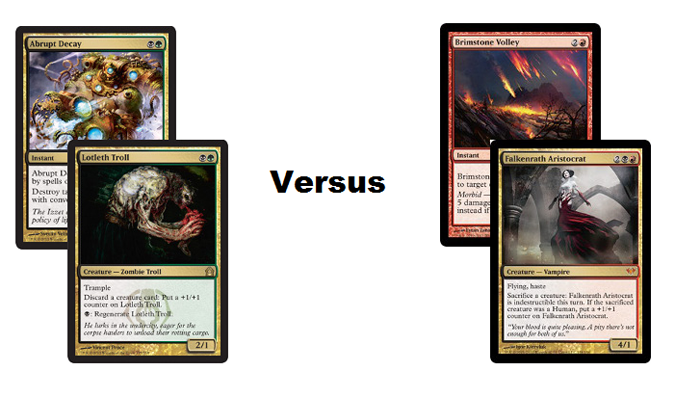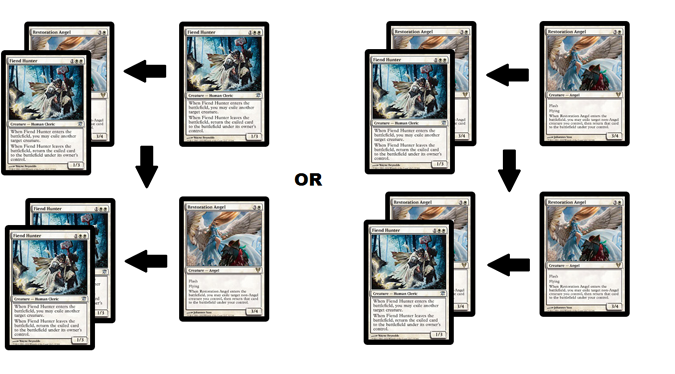It’s the end of September, and that means a new Standard format full of multicolored goodness! New formats are the best for deck-builders, presenting unique challenges and opportunities to be the one to “break it” first. There are so many new toys to play with and interactions to consider—almost anything can happen in the first few months of a format’s existence. There are no preconceptions, no net decks to speak of, and endless possibilities.
When building for a new format, you are rewarded for identifying powerful interactions, consistent engines, and successfully predicting what other people expect the format to look like. I want to take this as an opportunity to talk about how I approach new formats and give you a look at what I think the format will look like for the first month.
The Baseline
You always want to start by identifying the first level of the format. What’s the most obvious starting point—the most powerful and consistent shell? At this time last year, it was Liliana of the Veil plus Unburial Rites, and it later became Primeval Titan and Kessig Wolf Run. This time, everyone’s talking about Zombies.
B/G Zombies seems to be the most powerful, with Abrupt Decay and Lotleth Troll, but some people like the Jund build splashing for Falkenrath Aristocrat. I just want to be able to race the other Zombie decks with the reach that Falkenrath Aristocrat and Brimstone Volley give me.

[Cardlist Title=”B/r Zombies”]
- Creatures (29)
- 4 Gravecrawler
- 4 Diregraf Ghoul
- 4 Rakdos Cackler
- 3 Blood Artist
- 2 Highborn Ghoul
- 4 Rakdos Shred-Freak
- 4 Falkenrath Aristocrat
- 4 Geralf's Messenger
- Spells (8)
- 3 Brimstone Volley
- 2 Tragic Slip
- 3 Sign in Blood
- Lands (23)
- 4 Dragonskull Summit
- 4 Blood Crypt
- 4 Cavern of Souls
- 11 Swamp
So, what does this tell us? You have to be able to beat a few aspects of the Zombie deck: the triple-1-drop draw, the life loss from Geralf's Messenger, and the giant Lotleth Trolls and Dreg Mangler scavenges.
Getting Midrangey
What you’re looking for next is whatever the natural trump to Zombies is going to be. Something with early removal to answer 1-drops, life-gain to keep itself from being burned out, and less conditional removal for things like Falkenrath Aristocrat and Lotleth Troll. What you’re looking for is Jund:

Jund is a pretty straightforward foil to the Zombie strategy, and it is almost certainly the best midrange deck coming out of the gates. You have the best removal for the early and midgame and plenty of life-gain to deal with Zombies. But you also have planeswalkers, Olivia Voldaren, and Rakdos's Return to stop other midrangey decks from going over the top.
The deck can be tweaked quite a bit to adjust for how aggressive or controlling you expect the metagame to be, which will be a strength as the format develops. Awkwardly enough, that’s a weakness early on since you don’t have as clear an idea of what the format will look like. Here’s where I’d start with Jund:
[Cardlist Title=”Jund Midrange”]
- Creatures (10)
- 4 Huntmaster of the Fells
- 4 Thragtusk
- 2 Olivia Voldaren
- Spells (25)
- 3 Abundant Growth
- 3 Tragic Slip
- 2 Garruk Relentless
- 2 Liliana of the Veil
- 3 Dreadbore
- 3 Farseek
- 3 Pillar of Flame
- 2 Sever the Bloodline
- 2 Rakdos's Return
- 1 Flames of the Firebrand
- 1 Geistflame
- Lands (25)
- 4 Forest
- 3 Mountain
- 2 Swamp
- 4 Blood Crypt
- 3 Overgrown Tomb
- 4 Rootbound Crag
- 4 Woodland Cemetery
- 1 Kessig Wolf Run
Alternatively, you could look for B/U/G or Grixis variants that have similar a game plan against Zombies, but use blue planeswalkers and card-drawing to grind out the other midrange decks in the late game. These are the decks that will have a difficult time against Rakdos's Return, though, so I’m inclined to stick with Jund—its top-decks will generally be better.
Going Big
If you want to beat Jund, you need a deck that attacks from a different angle—something that’s strong against sorcery-speed removal and that can fight through multiple Huntmaster of the Fells and Thragtusks. You want something that has inherent advantages over Jund while still being able to put up a reasonable fight against Zombies.
In the previous format, this would have been something like the Primeval Titan decks, which just started casting Titans and trumping whatever everyone else was doing as the game went on. In this format, we don’t have the same kind of insane 6-drops that have defined Standard for the last few years.
Fortunately, there is a way to put the game out of reach of all but the most controlling of decks:
[Cardlist Title=”G/W Blink”]
- Creatures (29)
- 4 Fiend Hunter
- 4 Restoration Angel
- 1 Angel of Serenity
- 4 Thragtusk
- 4 Avacyn's Pilgrim
- 4 Arbor Elf
- 2 Trostani, Selesnya's Voice
- 1 Armada Wurm
- 3 Borderland Ranger
- 2 Elvish Visionary
- Spells (6)
- 1 Cloudshift
- 2 Selesnya Charm
- 1 Predatory Rampage
- 2 Garruk Relentless
- Lands (25)
- 3 Plains
- 7 Forest
- 3 Gavony Township
- 1 Grove of the Guardian
- 3 Seraph Sanctuary
- 4 Sunpetal Grove
- 4 Temple Garden
So, for those who aren’t familiar with how this deck works, here’s a quick rundown. You have plenty of life-gain against Zombies, and you have Fiend Hunter for Falkenrath Aristocrat and Geralf's Messenger. You have Gavony Township and Trostani, Selesnya's Voice to grind things out against Jund.
But you also have a way to just put the game out of reach of either of these decks from a stable board state. You have multiple four-card combos that gain you infinite life. Here’s how this works: You need two of either Fiend Hunter or Restoration Angel and one of the other, and you need either Seraph Sanctuary or Trostani. Then, either one of these loops results in infinite life:

The two things you’re most afraid of when playing a deck like this are instant-speed removal and sweepers. Fortunately, most of those cards are very bad against Zombies, so you shouldn’t see much of them early on. The only thing I’m really worried about being able to beat is Olivia Voldaren, but Selesnya Charm and Fiend Hunter should do a fine job of that.
But I Just Want to Kill Them!
Once the format starts spiraling up into midrange and moderately controlling decks, there’s usually space for a deck that punishes stumbling because of awkward mana or greedy keeps. Typically, this is something like Red Deck Wins or an aggressive W/x or similar deck. While there’s certainly space for something like that in this format, it seems poorly positioned when the top-tier deck requires significant amounts of life-gain and spot removal.
Instead, we want something that doesn’t care very much about either of those.
Rather, I think it’s better to return to one of the more successful decks from Pro Tour: Avacyn Restored, Bant Spirits:
[Cardlist Title=”Bant Spirits”]
- Creatures (25)
- 4 Geist of Saint Traft
- 4 Invisible Stalker
- 4 Avacyn's Pilgrim
- 3 Borderland Ranger
- 3 Strangleroot Geist
- 2 Arbor Elf
- 3 Centaur Healer
- 2 Wolfir Silverheart
- Spells (11)
- 4 Spectral Flight
- 4 Increasing Savagery
- 3 Abundant Growth
- Lands (24)
- 4 Cavern of Souls
- 4 Hinterland Harbor
- 2 Sunpetal Grove
- 4 Temple Garden
- 2 Hallowed Fountain
- 2 Island
- 1 Plains
- 5 Forest
The biggest issue with this deck before was the mana, and that’s largely fixed by Return to Ravnica. A deck like this is much better positioned than something like RDW because you don’t care very much about removal or life-gain since your threats are largely hexproof and your damage is creature-based instead of spell-based.
It’s very likely that a deck like this will have difficulty racing Zombies, but you’re counting on the other midrange decks to prey on that deck while you punish them for their awkward mana. This deck hasn’t changed very much from the Block version, but that’s largely because I haven’t played enough with the shell to know what slots in from Return to Ravnica. The point is that a Geist of Saint Traft plus Spectral Flight deck becomes well positioned when everyone is prepared to beat Zombies.
But What about Control Decks?
It can be difficult for control decks to find a space in new formats since you have to try to deal with specific threats. It’s hard to attack specific threats when you don’t know what level the metagame is going to start on. Realistically, this is where you have to figure out what the constraints on the format are and find the most efficient way to answer all of the questions the format has to offer. So, what are constraints on this format as we’ve constructed it so far?
- You can’t lose to Zombies.
- You have to be able to go over the top of multiple Thragtusks.
- You can’t lose going long to either Gavony Township or Kessig Wolf Run.
- You have to have more powerful top-decks than Jund in the mid- and late-game.
- You have to be able to interact with Geist of Saint Traft.
Generally, it’s easiest to start by figuring out how you’re going to kill opponents and work backward to figure out how you make it to that board state. In this case, the most obvious direction to go is W/U/x miracles because of Terminus and Entreat the Angels. How does that stack up to the constraints we’ve set?
Because of the nature of the miracle mechanic, your top-decks are going to be better than any other deck’s as the game goes long. Depending on how good your mana is, you could splash for early removal such as Pillar of Flame to fight more against Zombies. You don’t care about Thragtusk because you can just miracle Entreat the Angels for a billion, and your sweepers give you game against G/W and Geist of Saint Traft. That all seems reasonable to me, so here’s where I’d start:
[Cardlist Title=”W/U Miracles”]
- Spells (35)
- 4 Thought Scour
- 4 Think Twice
- 3 Azorius Charm
- 2 Feeling of Dread
- 3 Jace, Architect of Thought
- 2 Tamiyo, the Moon Sage
- 4 Terminus
- 3 Entreat the Angels
- 1 Dissipate
- 4 Temporal Mastery
- 4 Detention Sphere
- 1 Supreme Verdict
- Lands (25)
- 4 Glacial Fortress
- 4 Hallowed Fountain
- 3 Ghost Quarter
- 7 Island
- 7 Plains
It’s important to recognize that you’re very soft to planeswalkers outside of Detention Sphere. This might necessitate some number of Snapcaster Mage or something similar to help apply pressure to planeswalkers. You’ll have some trouble against Zombies unless you miracle a Terminus between turns three and five, but you’re certainly capable of beating them.
Wrapping Up
This is just the start of what Return to Ravnica has to offer. This promises to be a deep and exciting format where subtle choices in flex slots and sideboard cards have huge rewards. We haven’t even started talking about Lingering Souls, and that card was good enough to be banned in Block! Sorin, Lord of Innistrad plus Anthems seems very strong against Zombies, and that archetype gives you Lingering Souls as well.
Delver of Secrets is still going to be a very good card. Some tempo shell with Snapcaster Mage, Geist of Saint Traft, and Azorius Charm will almost certainly be playable.
How is the format going to play out? Which decks are going to take over? There’s only one way to find out! Try new things; play with strange cards; tweak your numbers. Just be sure to keep in mind what you expect the format to look like and the interactions and decks you want to be able to beat. If you put in the time, you could be the one who designs the next top-tier deck!
























